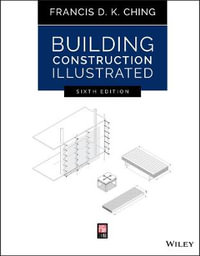About the Author xv
Preface xvi
Acknowledgments xvii
1 Introduction 1
1.1 Role of Hydraulics and Pneumatics in Environmental Engineering Design 1
1.2 Scope, Organization, and Approach 2
1.3 Fluid Flow Phenomena 3
1.4 Definitions and Classifications of Flows 5
1.5 Viscosity 6
1.6 Dimensional Units and Notation 8
2 Mass, Momentum, and Energy 9
2.1 Introduction 9
2.2 Closed Systems and Control Volumes 9
2.3 Conservation of Mass 10
2.4 Linear Momentum 15
2.5 Moment of Momentum 17
2.6 Conservation of Energy 19
2.7 Differential Equations for Pipe and Channel Flows 27
3 Navier–Stokes, Dissipation Function, and G-Value 33
3.1 Introduction 33
3.2 Navier–Stokes Equations 33
3.3 Dissipation Function 37
3.4 Critical Review of G-Value Theory 39
4 Analytical Solutions of the Navier–Stokes and Related Equations 41
4.1 Introduction 41
4.2 Potential Flow, Zero Slip, Boundary Layers, and Prandtl’s Synthesis 41
4.3 Potential Flow Solutions 47
4.4 Laminar Flow Solutions 50
4.5 Creeping Flow 56
4.6 Flow through Porous Media 58
4.7 Turbulence, Separation, and Secondary Currents 59
5 Dimensional Analysis and Similitude 63
5.1 Introduction 63
5.2 Fundamentals 63
5.3 Reduction of Experimental Data 64
5.4 Generalized Numerical Solution of Differential Equations 67
6 Incompressible Flow in Pressure Conduits 83
6.1 Introduction 83
6.2 Steady Flow in Pressure Conduits 83
6.3 Simple Changes in Cross Section 87
6.4 Branching Flows 92
6.5 Valves and Other Appurtenances 98
6.6 Pipe Networks 116
6.7 Time-Varying Flow 120
7 Flow in Open Channels 137
7.1 Introduction 137
7.2 Critical Flow Conditions 137
7.3 Uniform-Flow Conditions 158
7.4 Subcritical Flow 161
7.5 Supercritical Flow 166
7.6 Sewer Transitions, Junctions, and Drops 180
7.7 Culverts and Related Outlet Structures 183
7.8 Outfall Structures and Scour Protection 190
7.9 Time-Varying Flow 205
8 Pumping, Equalization, and Waterhammer 207
8.1 Introduction 207
8.2 Centrifugal Pumps 207
8.3 Positive-Displacement Pumps 215
8.4 Miscellaneous Types of Pumps 217
8.5 Equalization 218
8.6 Waterhammer 222
8.7 Wet Wells 256
8.8 Stormwater Pumping Station Design 257
9 Compressible Fluid Flow 265
9.1 Introduction 265
9.2 Gas Properties 265
9.3 Constant Flow in Pipes 277
9.4 Flow Meters: Venturi Tubes, Flow Nozzles, Orifices 288
9.5 Blowers and Compressors 298
10 Concepts of Spatially Varied Flow 307
10.1 Introduction 307
10.2 Background 307
10.3 Spatially Varied Free-Surface Flows 308
10.4 Relation Between Momentum and Energy Formulations 312
10.5 Difference Formulation 314
10.6 Spillway Flow 315
10.7 Recapitulation 317
11 Distribution Conduits 319
11.1 Introduction 319
11.2 Distribution Principle 319
11.3 Spatially Decreasing Flows in Distribution Conduits 327
11.4 Slope Invariance for Pressure Conduits 338
11.5 Karman Vortex Street 341
12 Collection Conduits 347
12.1 Introduction 347
12.2 Rectangular Channels 348
12.3 Nonrectangular Channels with Constant Top Width 353
12.4 Prismatic Channels with Varying Top Width 354
12.5 Conduits with Spatially-Increasing Flow 362
12.6 Numerical Solutions 370
12.7 Street Gutters and Grates 378
13 Sediment Transport: Flow of Sludges and Slurries 389
13.1 Introduction 389
13.2 Limiting Velocity Concepts 389
13.3 Induced Circulation in Channels 394
13.4 Pressure Drop in Sludge and Slurry Flows 404
13.5 Drag Reduction in Conduits 405
14 Process Applications 407
14.1 Introduction 407
14.2 Basic Reactor Concepts 407
14.3 Sedimentation and Thickening 408
14.4 Mixing 415
14.5 Chemical Contact 419
14.6 Flocculation and Floc Breakup 424
14.7 Aeration and Postaeration 428
14.8 Filtration and Fluidized Beds 438
14.9 Washwater Trough External Flow 447
15 Introduction to Hydraulic Aspects of Natural Systems 451
15.1 Introduction 451
15.2 Rivers 451
15.3 Lakes, Ponds, and Freshwater Wetlands 460
15.4 Estuaries 473
15.5 Ocean Waters 477
15.6 Groundwater 479
References 495
Index 521
























